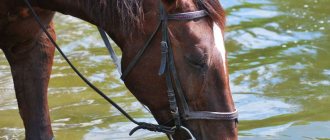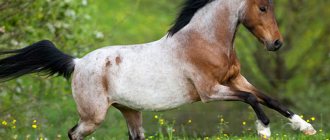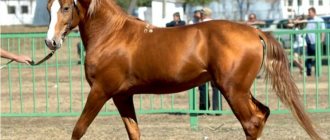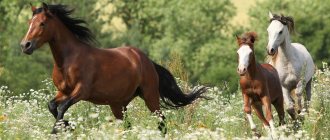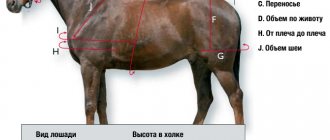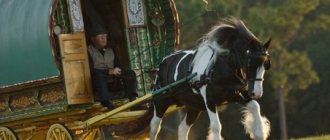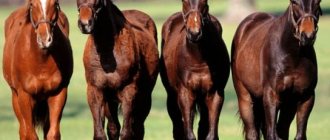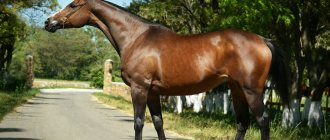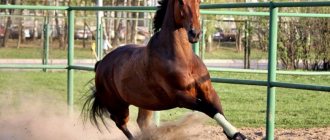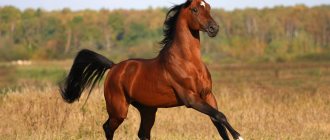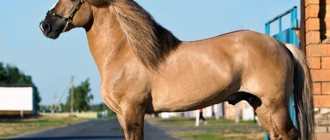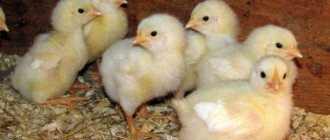The Mongolian horse is a breed of strong and hardy animals. Despite the harsh conditions of Mongolia, representatives of this breed not only did not become extinct, but turned into a large population of strong and unpretentious horses.
Origin story
Not long ago, archaeologists found documentary evidence of the existence of the Mongolian breed in ancient times. Horse riding among the adult population of Mongolia was a popular activity long before our time. The information obtained dates back to 2000 BC. The origin of Mongolian horses is assumed to be from the northern Tarpan race.
The breed was formed as a result of the survival of the strongest individuals. The unfavorable climate of the steppe lands, independent food production in areas sparsely covered with vegetation, contributed to the fact that only the strongest and most resilient horses survived and gave birth to offspring.
Animals have been getting their own food for hundreds of years. In winter, they had to shovel the snow cover to get to food.
The climate of central Mongolia is milder, but it is more difficult to obtain edible food there. Only in the northern part of the country could animals obtain sufficient amounts of grass. Therefore, the severity of the northern regions was reflected in the exterior and characteristics of the breed.
Breeding
Breeding horses on the Mongolian steppe is not an easy task. The harsh climate, constant droughts and strong winds have formed the special specifics of horse breeding.
The main feature is the continuous movement of livestock. In winter, when there is no forage grass, they try to keep herds in areas isolated from the wind. The winter wind in the great steppe can kill an animal, so horses need protection.
In the spring, when the herds are driven to rivers and other bodies of water to graze, the animals regain their strength. This time is considered the most favorable for breeding. In addition, they try to fertilize females at this time for other reasons. It is important that the foal is born next summer, when there is plenty of food in the steppes.
Only healthy individuals are allowed for breeding. Thanks to this, the breed has remained one of the strongest, hardiest and smartest for thousands of years. The age of the animals is also important – from 3 to 10 years. During this period they give the healthiest and strongest offspring.
Main characteristics of the breed
Of the characteristic advantages of the Mongolian horse breed, the following is noted:
- endurance and intelligence;
- lightning-fast orientation while running;
- getting used to any living and living conditions;
- devotion and loyalty to the owner.
Due to the fact that the Mongolian horse quickly accumulates subcutaneous fat, it can withstand strong 80-degree temperature changes in winter. The main feature is the economical use of water and food at any time of the year. Even in the summer heat, the animal can get by with a small amount of water.
The Mongolian breed has a life expectancy that can reach 20 years or more.
Exterior
A horse's breed and conformation are most valued. A distinctive feature of the Mongolian breed is considered to be a dense, elongated body with a height at the withers of approximately 127-128 cm in mares and stallions, respectively. The animal has a muscular short neck and a large head with a long mane. Short legs with stable and strong hooves help to overcome long distances, which is important for a nomadic lifestyle. This feature of the structure of the hooves makes it possible not to use horseshoes.
Thick hair helps preserve energy in unfavorable climates. In winter, the cover lengthens, protecting the animal from hypothermia.
Common colors are bay, red, black, gray horse.
Character and disposition
Despite its original military purpose, the Mongolian horse is characterized as an animal with a kind and flexible disposition.
Traditionally, every family has a horse. Even small children trust her. From early childhood, the child is placed in the saddle, teaching him how to sit in it correctly. With a rider in the saddle, the horse does not try to free itself. Gets used to the owner quickly.
Although most herds graze freely, the animals quickly get used to people. After getting to know each other, the horse becomes obedient and friendly.
Diet
Constant presence in the natural environment made these animals unpretentious not only in maintenance, but also in food.
Mongolian horses, even when under saddle for a long time, quite calmly manage with pasture, while moving for hours with a rider on their back. During the warm season, the basis of their diet is fresh green plant food of natural origin, and in winter - hay.
Also, as a source of essential minerals and vitamins, their diet includes cereals and vegetables (fodder beets, carrots, potatoes, and so on). A piece of crushed sugar works very well as a treat.
More on the topic: How to make a saddle for a horse?
Main scope of application
During the time of Genghis Khan, the Mongolian horse was an integral participant in all military battles.
The popularity of using the Mongolian horse in our time has been gained through horse racing, which is supported by the state and is the main purpose of breeding this breed in Mongolia. Young foals are trained for long distance racing starting in their first year of life. A good horse with a light rider in the saddle covers a distance of 25 km in forty minutes.
To obtain better results during racing, the horse is placed on a special feeding regimen. Increased agility is achieved by feeding the animal only at night.
The annual Naadam holidays are not complete without competitions with a large number of participants. Before the celebration, the horse is decorated in the traditional style.
The bridle is sewn from openwork braid with national patterns. The festive saddle, colorful and bright, is covered with silver elements and inserts. Stirrups are made in the form of chasing or engraving.
Participants ride out into the steppe where competitions are held.
Mentioning the next area of application of the Mongolian horse breed, we note that the Mongols do not eat horse meat. The country's population has a special relationship with horses. Meat as a food product is used only for export to other countries.
But the product obtained from mares is used for consumption. Airag drink is made in 2 consistencies:
- thick - to satisfy hunger;
- liquid drink quenches thirst.
The importance of horses in Mongolian culture
Historically, the Mongols are a nomadic people. A Mongol without a horse is like without hands. During the Middle Ages, each free Mongol had several horses. Only slaves did not have their own animals.
The harsh climate of the Mongolian steppes and the lack of fertile soil forced local residents to lead a nomadic lifestyle, which in those conditions was impossible without horses. Therefore, they could not help but fit into the local culture.
Traditional Mongolian folklore consists of tales about the nomadic way of life, songs about horses and military campaigns.
Nomadic people Mongols
Horse riding is the most popular sport in Mongolia. Even in the 21st century, boys are given horses on their third birthday.
Interesting Facts
- The nomadic Mongolian tribes always treated horses with care. For displays of cruelty, the horse could be taken away from the owner, and he himself could be kicked out of the tribe.
- In the 12th century, the urton service appeared in Mongolia. This is a system for horse-drawn message delivery with the organization of roads, stations for changing horses, and wells. The main characters were horsemen and Mongolian horses. In Europe, the institution of messengers was organized fragmentarily 2 centuries later.
- Chubara (leopard) color is not often found among horses. Personal envoys and messengers of Genghis Khan used forelock horses. It was an ancient analogue of the current flashing lights on cars in the motorcade of high-ranking persons.
- Genghis Khan died suddenly at the age of 65. The cause of the emperor's death is said to be illness, a wound received from a captured Tangut princess. One of the main versions is considered to be a fall from a horse. Which is very reminiscent of “death by one’s horse.”
- The Great Patriotic War turned free Mongolian horses into front-line soldiers. In the army, every fifth horse was from Mongolia. From 1941 to 1945, about half a million heads of steppe horses and mares were imported into our country.
- a monument to Mongolian horses was erected and inaugurated in Moscow . This happened on May 5, 2022 on Poklonnaya Hill. The monument was created by sculptor Ayuurzan Ochirbold.
Mongolia is the most horse country in the world. Its population is slightly more than 3 million 200 thousand people. Mongolian herds number 2 million heads. That is, for every three people there are 2 horses. The ratio is constantly changing and is not in favor of short, hardy, wayward horses.
Sources:
https://fermhelp.ru/loshadi-mongolskoj-porody/ https://stroy-podskazka.ru/loshadi/porody-i-masti/mongolskaya/ https://givotniymir.ru/mongolskaya-loshad-opisanie-osobennosti- uhod-i-tsena-mongolskoy-loshadi/
Photo gallery
We invite you to look at several photos of Mongolian horses from our photo gallery. Photo 1. Girl with her horse
Photo 2. Two Mongolian horses on a leash
Photo 3. Mongol horsemen in the field
Horse racing
The Ulaanbaatar Hippodrome is an outstanding landmark of the country. The speed record for a distance of 1600 m is 2 minutes and 6 seconds; the best horses overcome 3200 m in 4 minutes and 23 seconds. As part of the Mongolian national holiday Naadam, about 40 thousand horses compete. The length of the distances varies from 16 to 32 km. In Naadam racing, the age limit for riders is strictly observed - children from 5 to 14 years old. The fastest Mongolian horses come from Undurkhan, from where they came to other regions of the country and to China.
Horse racing procedure:
- 1st race - two-year-olds - distance 15 km.
- Race 2 – three-year-olds – 20 km.
- Race 3 – four-year-olds – 25 km.
- Race 4 – five-year plan – 28 km.
- Race 5 - other age categories (over 5 years old) - 30 km.
- Heat 6 – stallions – 28 km.
- Heat 7 - pacers.
References
- ^ a b "Masson Smith" (PDF). afe.easia.columbia.edu. Retrieved August 25, 2014.
- ^ ab Udina, I.G. "Computer analysis of mitochondrial DNA D-loop changes in Asian horse breeds" (PDF). bionet.nsc.ru
. - ^ ab Kefena, E.; Mekasha, Y.; Han, J. L.; Rosenbom, S.; Haile, A.; Dessie, T.; Beja-Pereira, A. (2012). "Inconsistencies between morphological systematics and molecular systematics in the equid stem lineage: a review of the case of taxonomy of the genus Equus". Animal husbandry
.
143
(2-3): 105. DOI: 10.1016/j.livsci.2011.09.017. - ^ a b Cheng, P. (1984). "Cattle Breeds of China". Animal Production and Health Paper
46 (E, F, S). Publ. FAO, Rome, 217 pp. - ^ abcde Jazdzik, Elizabeth (April 1, 2011). "Mongolian horse and rider". Collected Papers of the Independent Study Project (ISP) 1068. Retrieved August 8, 2014.
- Kendall, Elizabeth. Traveler in China,
Chapter 13. 1913. Traveler in China - ^ a b c d https://digitalcollections.sit.edu/cgi/viewcontent.cgi?article=1543&context=isp_collection
- Hakluyt, Richard (1903). Texts and versions by John de Plano Carpini and William de Rubruckis: How... - Richard Hakluyt, Giovanni (da Pian del Carpine, Archbishop of Antivari), Willem van Ruysbroeck - Google Books. Retrieved August 25, 2014.
- Haslund, Henning. In Secret Mongolia, page 110.
- ^ abc "Tim Cope - traveling from Mongolia to Hungary!" . Thelongridersguild.com. Retrieved August 25, 2014.
- Bayarsaikhan, B. Travel on Mongolian horses,
p. 102 - "Severe winter kills two million livestock." Montsame News Agency, Ulaanbaatar. 2010-02-11. Retrieved February 14, 2010.
- "Microsatellite variations in Japanese and Asian horses and their phylogenetic relationships using the European equine group." jhered.oxfordjournals.org. Retrieved August 8, 2014.
- https://cricket.biol.sc.edu/papers/horses/Genetic%20Variation%20in%20Przewalski%27s%20horses,%20with%20special%20focus%20on%20the%20last%20wild%20caught%20mare,%20231% 20Or.pdf
- Haslund, Henning. In Secret Mongolia,
page 110. - "Proceedings of the Third International Conference on Bioinformatics of Genome Regulation and Structure" (PDF). Siberian Branch of the Russian Academy of Sciences. 2002. Retrieved August 8, 2014.
- "Microsatellite variations in Japanese and Asian horses and their phylogenetic relationships using the European equine group". jhered.oxfordjournals.org. Retrieved August 8, 2014.[ dead link
] - The Horse in Japan, 1615-1912 Archived 2014-08-21 at the Wayback Machine (gallery exhibition guide, September 20 - November 12, 2010). Berea, KY: Berea College Art Gallery. As of August 2014
- "Archive copy" (PDF). Archived from the original (PDF) on September 24, 2015. Retrieved August 20, 2014. CS1 maint: archived copy as title (link)
- Jansen, T; Forster, P; Levin, M.A.; and others. (August 2002). "Mitochondrial DNA and the origins of the domestic horse". Proceedings of the National Academy of Sciences
.
99
(16):10905–10910. Bibcode: 2002PNAS...9910905J. DOI: 10.1073/pnas.152330099. PMC 125071. PMID 12130666. - ^ ab https://hwcdn.libsyn.com/p/e/2/a/e2a1d0358bc915f8/dchha43_Wrath_of_the_Khans_I.mp3?c_id=4619666&expiration=1407651729&hwt=420e072218cefc055e8909
- Davis, Matthew. When it gets dark: a Mongolian winter tale, p. 169.
- "Article: Horse in Mongolian culture". amnh.org. 2014-05-01. Archived from the original on 2015-05-02. Retrieved August 25, 2014.
- New complete documentaries about Atlantis (2012-04-09). "Mongolia". YouTube. Retrieved August 29, 2014.
- Khan, Paul. The Secret History of the Mongols: The Origin of Genghis Khan, p. 108.
- https://lh3.ggpht.com/—JtLlx-OIIQ/TlF3_0LC1pI/AAAAAAAAEkU/Yonhm0Qcdzw/s1600/Mongolia+gift.jpg
- Hoang, Michelle. Genghis Khan. New Books Amsterdam, 1991.
- ^ ab Sventoslavsky, V. "Confrontation of two worlds: weapons and armor of Central European and Mongolian troops in the first half of the 13th century" (PDF). rcin.org.pl.
_ - https://afe.easia.columbia.edu/mongols/conquests/khans_horses.pdf
- Splitting. The Secret History of the Mongols, page 126
